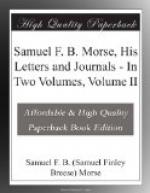“In coming from Whitesboro on Friday I met with an accident and a most narrow escape with my life. The horse, which had been tackled into the wagon, was a vicious horse and had several times run away, to the danger of Mr. Dexter’s life and others of the family. I was not aware of this or I should not have consented to go with him, much less to drive him myself.
“I was alone in the wagon with my baggage, and the horse went very well for about a mile, when he gradually quickened his pace and then set out, in spite of all check, on the full run. I kept him in the road, determined to let him run himself tired as the only safe alternative; but just as I came in sight of a piece of the road which had been concealed by an angle, there was a heavy wagon which I must meet so soon that, in order to avoid it, I must give it the whole road.
“This being very narrow, and the ditches and banks on each side very rough, I instantly made up my mind to a serious accident. As well as the velocity of the horse would allow me, however, I kept him on the side, rough as it was, for about a quarter of a mile pretty steadily, expecting, however, to upset every minute; when all at once I saw before me an abrupt, narrow, deep gully into which the wheels on one side were just upon the point of going down. It flashed across me in an instant that, if I could throw the horse down into the ditch, the wheels of the wagon might, perhaps, rest equipoised on each side, and, perhaps, break the horse loose from the wagon.
“I pulled the rein and accomplished the object in part. The sudden plunge of the horse into the gully broke him loose from the wagon, but it at the same time turned one of the fore wheels into the gully, which upset the wagon and threw me forwards at the moment when the horse threw up his heels, just taking off my hat and leaving me in the bottom of the gully. I fell on my left shoulder, and, although muddied from head to foot, I escaped without any injury whatever; I was not even jarred painfully. I found my shoulder a little bruised, my wrist very slightly scratched, and yesterday was a little, and but very little, stiffened in my limbs, and to-day have not the slightest feeling of bruise about me, but think I feel better than I have for a long time. Indeed, my health is entirely restored; the riding and country air have been the means of restoring me. I have great cause of thankfulness for so much mercy and for such special preserving care.”
[Illustration: ELIZABETH A. MORSE Painted by Morse]
The historian or the biographer who is earnestly desirous of presenting an absolutely truthful picture of men and of events is aided in his task by taking into account the character of the men who have made history. He must ask the question: “Is it conceivable that this man could have acted thus and so under such and such circumstances when his character, as ultimately revealed through the perspective of time, has been established? Could Washington and Lincoln, for example, have been actuated by the motives attributed to them by their enemies?”




